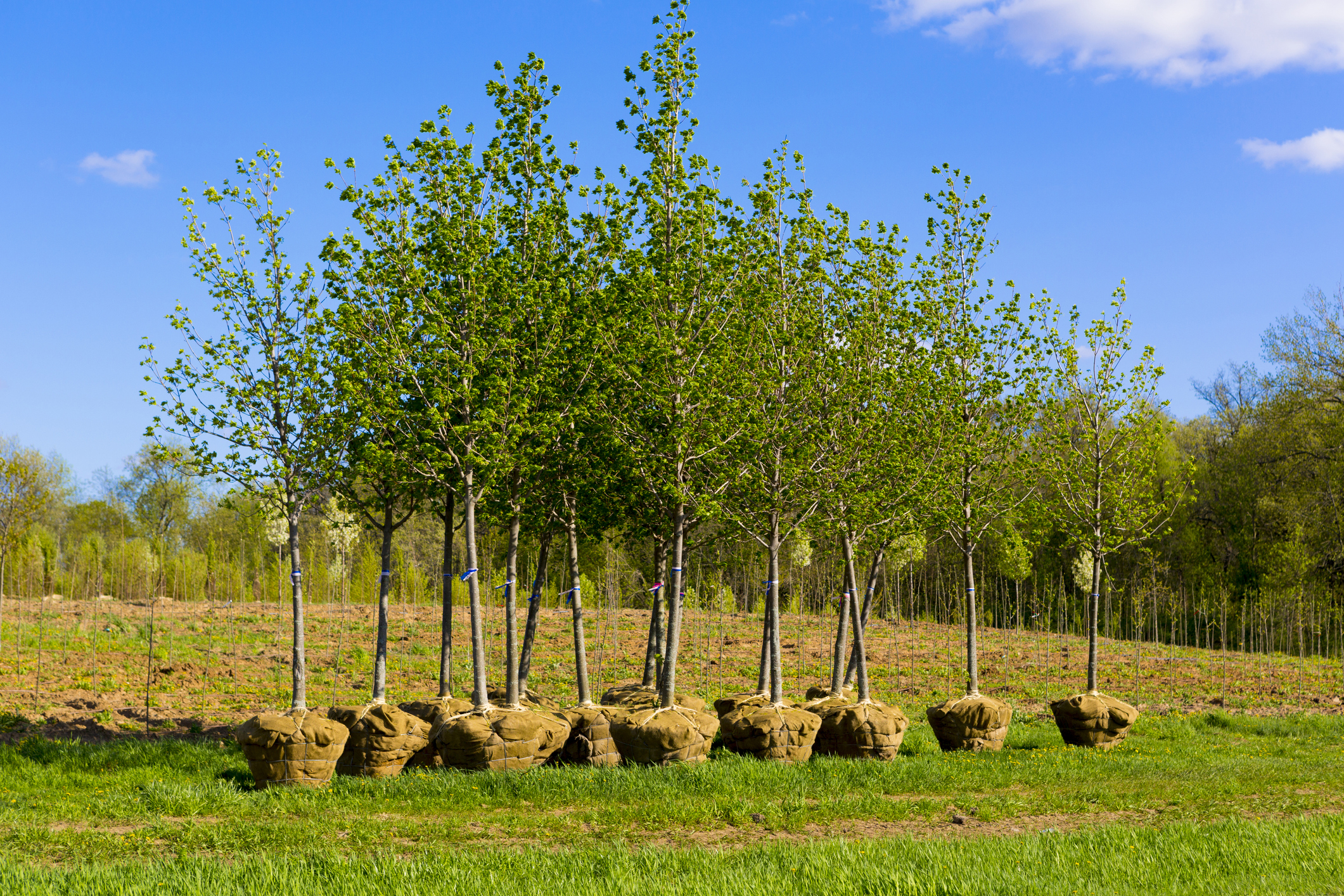
This factsheet covers key points to consider when choosing trees and shrubs for your local planting projects. It provides step-by-step guidance communities can follow to ensure the right trees are planted in the right places to achieve their urban forestry goals, beautify the landscape and deliver the long-term benefits of a healthy community canopy.
This factsheet was created to support small and rural communities who are just developing their urban forestry approaches and content might be helpful for municipal staff working in various departments such as public works, recreation or public health services.
Why does stock selection matter?
Stock selection is all about choosing high-quality trees and shrubs to plant that are suitable for local conditions. This process includes determining the required stock size, selecting the right species and evaluating the condition and quality of young trees before purchasing and planting them. Well-chosen stock should be aligned with your project’s planting objectives and compatible with the planting location.
Selecting the right stock is critical for tree establishment and growth. High-quality trees and species that are well-suited to the planting site are more likely to thrive and achieve their intended benefits. Choosing the most appropriate species for the site is also the best way to increase biodiversity and support the broader ecosystem.
Choosing the right species to plant
First, consider the objectives of your planting project when selecting what species to plant. What are your community’s planting or other sustainability goals, such as canopy cover or biodiversity targets? Do you have site-specific objectives, such as flood mitigation or urban heat island mitigation? What are the traits the selected species should have to best meet these objectives and suit the site conditions?
For example, if you are looking to mitigate urban heat island effects in a neighborhood prone to hot and dry conditions, you would choose drought-tolerant species that can withstand harsher conditions. Or, if your objective is to restore habitats for species-at-risk or to restore forests in naturalized areas, you would consider choosing a diversity of native species that grow well in existing conditions.
There are several factors to consider when choosing which species to plant:
Suitability
Choose species well-suited to the local environment and planting site. Consider water use, shade tolerance, wind tolerance and physical limitations. Determine which plant hardiness zone your area is in to understand what species can survive the lowest temperatures. Whenever possible, choose nursery stock that has been grown locally or in a similar climate.
Species should also be suitable for future climate scenarios. This may mean selecting more resilient species that can tolerate warmer or dryer conditions, choosing fire-resistant species in fire-prone areas and avoiding species that are threatened by endemic pests and diseases. Regional climate models can help you evaluate how local conditions may change over time.
Diversity
Aim for a diversity of species for a tree canopy that is more resilient to pest and disease infestations. Adopt a diversity guideline to inform stock selection, such as the 10-20-30 rule, which recommends having no more than 10 percent of one species, 20 percent of one genus and 30 percent of one family in an urban forest population. These guidelines can be adjusted according to the diversity of species the local climate can support. Alternate methods include ensuring functional diversity in the trees you select, so that different traits, such as tolerance to shade, droughts or floods, are well-represented.
Consider shrubs (smaller, multi-stemmed, woody plants) for part of restoration or habitat planting projects, for edible planting projects, or for specific sites within the project where tree planting is not viable.
Native vs. non-native species
It’s important to select regionally and genetically appropriate seed stocks that are likely to survive a changing climate. Choose native species whenever possible for natural areas and where site conditions permit as they support native habitat and biodiversity.
In urban settings, non-native species can be better adapted to conditions or more resilient to climate change. However, extra care is needed when choosing non-native species. Invasive species should be avoided as they can have very detrimental effects on local ecosystems and biodiversity. It is important to ensure the selected species comply with local regulations.
Aesthetics and maintenance
Consider the species’ appearance and maintenance needs, including potential nuisances like allergens. Trees grow in a variety of forms and colours that can beautify landscapes. Factors such as fall colour, flowers or fruit and growth form should all be considered in species selection.

Ensuring the stock you choose is high quality
Nursery stock comes in various ages, sizes and types. Here are common types you may choose from:
Seedlings are very young trees, easy to plant in large numbers, easy to transport and inexpensive. They are most appropriate for natural planting or large-scale planting (e.g., replanting a forest). They are less well-suited for street tree planting or planting in high traffic areas as they can be easily damaged.
Bare-root trees are transplanted without soil on their roots. This means they are lighter, but it also makes them more susceptible to root damage. It’s important to keep them moist if they are not going to be planted immediately.
Container-grown trees and shrubs are often grown in artificial soil in various sizes. They are easy to handle and transport, but their roots can girdle and be restricted by the container size. Also, winter conditions can damage container-grown trees if they are grown above ground because they are less protected from cold temperatures. However, they can be moved inside more easily before planting if needed.
Ball and burlap trees are commonly larger trees, grown in the soil at the nursery and then removed with their roots and soil covered by burlap material. The root ball protects the roots during transport, but ball and burlap trees are heavier and more difficult to transport. Their large size makes ball and burlap trees more resistant to damage and therefore more appropriate for planting in high traffic areas.
Consider the type of trees and shrubs that will best suit your planting needs and contact a local nursery to source suitable stock. Always assess nursery stock to ensure plants are high quality and likely to establish and grow after planting. Young plants should be inspected at the nursery and upon delivery in accordance with the Canadian Landscape Standard and Canadian Nursery Stock Standard.
Here’s a quick guide you can follow when inspecting nursery stock for acceptance:
Is the stock free of pest and disease?
Is it free of invasive weeds in the root ball?
Is it free of injury or other defects?
Is it free of girdling roots (roots that grow in a circular pattern around the trunk, or at or below the soil line)?
Is it free of co-dominant leading stems (single leader present)? (This is for trees only.)
Are branches well-spaced and not crowded? (This is for trees only.)
Does the trunk increase in diameter closer to the root ball (also called trunk taper)?
Make sure to plan the logistics of accepting, transporting and storing nursery stock, especially if you will not be planting immediately. For example, you will want to ensure that plants are stored in the shade and any coverings used to protect leaves or roots are removed to avoid excessive heat stress. Work with your contractor or the nursery to ensure the successful transfer and storage of trees and a timely planting operation.
Opportunities to involve the community
Engaging the community in stock selection can foster urban forest stewardship and create educational opportunities. For example, residents can play a role in selecting species for planting projects in their own neighbourhoods and learn how to select, plant and care for trees on their own properties. By involving community members, local governments can gather valuable feedback on the types of trees preferred and educate people about the reasons behind stock selection. This engagement empowers residents to participate in decisions that impact their environment, promotes a sense of shared responsibility for the urban forest and can encourage good tree planting practices across the community.
Next steps
Here are additional resources that can help you get started with stock selection:
Canadian Nursery Landscape Association, Canadian Nursery Stock Standard
Landscape Ontario, Ontario Landscape Tree Planting Guide
Government of Canada, Forest Change adaptation tools
Tree Canada, Compendium of Best Urban Forest Management Practices: Chapter 8. Species Selection and Planting
Tree Canada, Compendium of Best Urban Forest Management Practices: Chapter 16. Invasive Plant Species
This resource was created in partnership by Tree Canada and FCM’s Green Municipal Fund for the Growing Canada’s Community Canopies initiative, which is delivered by the Federation of Canadian Municipalities and funded by the Government of Canada.



 Choosing the right species to plant
Choosing the right species to plant